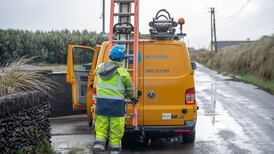WILD GEESE:Brian Keaney, Co-founder of Tonfisk Design
“WE COULDN’T think of a better name,” says Brian Keaney of why his Finland-based design company bears the name Tonfisk.
Meaning “tuna fish” in Swedish, the name was the result of a brainstorm in a friend’s kitchen back in 1999 when, fresh out of college, he and fellow graduate Tony Alfström decided to take the plunge into business.
“Tony thought it was a really great word and I thought, ‘why the hell are we going to call it tuna fish . . .’ but then we thought about it and said we could do anything under that name. It doesn’t restrict us.”
Now 11 years later, selling tableware and interior decoration items in more than 20 countries, in outlets from St Petersburg to Dublin, Tonfisk is on its way to becoming one of Scandinavia’s best-known design brands. The journey started with a tea set.
Graduating with a degree in industrial design from the National College of Art and Design in 1996, and with just a “handful” of jobs in the sector, the young Keaney, like most of his classmates, opted for further study.
Having been to Finland as an exchange student, the hands-on access to metal and wood workshops there attracted him back for a two-year masters degree in ceramics and glass at the University of Art and Design in Helsinki.
On graduating aged 24, he and Alfström decided that, instead of chasing scant freelance design work, they might as well go into business for themselves.
“We had few products at the time and we thought, ‘why not set up the brand and try selling our own products’?” says Keaney. “We thought at least we’d get some more experience and a portfolio.”
He says the pair was sure from the outset about what they wanted to achieve. “We wanted to create something very significant. We wanted that, 10 years down the road, our company would be recognised as one of the brands in Scandinavian design.”
Keaney’s warm tea and coffee set, a thesis project that combined ceramics with bracelets of laminated wood, which act as handles and help insulate the beverage, became the foundation stone of the business.
With Tonfisk’s collection expanding over time to include items such as quirky angled candle sticks, telescopic vases and a combined milk and sugar jug that tests gravity, the designs bear out the company’s philosophy that though form follows function, “all objects don’t have to look the same”.
So was it easy to set up a business in Finland? Keaney cites courses for would-be entrepreneurs, the ease of getting credit and generous government supports for attending overseas trade fairs as the positives – though taxes and employee pension payments are more onerous in his adopted country.
For young designers thinking of following in his footsteps, he advises beginning with enough seed capital. “We bought the kiln and set up the studio space and were immediately out of capital” he recalls. “We had a knife to our throats probably from day one . . . For somebody setting up, they need to have enough capital so that they can ride things out for the first six months.”
Of Tonfisk’s success at seeding its creations in design shops around Europe, he says it has been achieved through meeting retailers at design fairs.
With its products featured in design bibles, he feels that being Finland-based has also brought its own kudos.
“Finland has a long background in design so there’s that sense that it’s good to be from Finland internationally. People immediately look on your designs in a positive manner.”
While good design may stand the test of time, Tonfisk like any business was not immune to the recession.
Keaney says the downturn bit for the company in the autumn of 2008 when many buyers simply closed their Christmas order books.
“A lot of shops got freaked out and decided they would try to ride things out and get by with what [stock] they had . . . the following year, prices became more competitive and the whole category came down by about 20 or 30 per cent.”
He says this forced some companies to outsource their manufacturing to China. But Tonfisk, continuing to base its factory in Turku in Finland, instead tweaked its sales strategy. “Before the downturn, we concentrated on selling to retail but now, we’re doing more direct selling through our website and through different sales events.” It’s a strategy he says saved many small design companies.
With products ranging from € 20 for an espresso cup to € 100 for a large teapot, who is the Tonfisk customer? Keaney says, in the export market, it’s people interested in design and interiors, and more and more of them are ordering directly from the company’s website.
So what does he think of the mass production philosophy of neighbouring Nordic home ware giant Ikea?
“Mass production isn’t something I’m against,” he says, admitting a fascination with Ikea’s modus operandi. “If Tonfisk did go mass production, if we had the finance and the ability to do that, it would require its own expertise and capital. Some small designers want “it’s made in Finland” or “it’s handmade”. For us, it’s not a must but it’s just the reality of where we are. I think most young designers would love the opportunity to work with much bigger distribution possibilities.”
In Dublin on June 9th to address a World Crafts Council meeting on market positioning and brand identity, Keaney feels the future of Tonfisk is bright.
With his warm tea set since added to the collection of several museums including Les Arts Decoratifs in Paris, which is part of the Louvre, Keaney’s faith in his thesis project to become the foundation of a business was well placed.
“Things are looking good at the moment – we’ve turned a corner and new products are coming online all the time,” he says. “We’ve got a very good and interesting brand. That gives us great possibilities to really build the company.”












